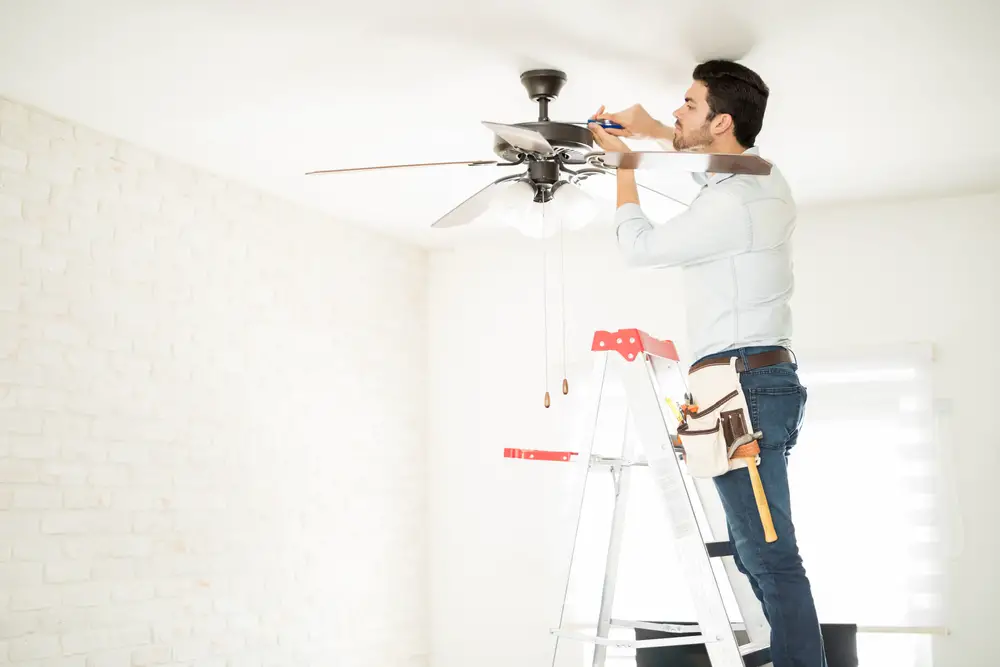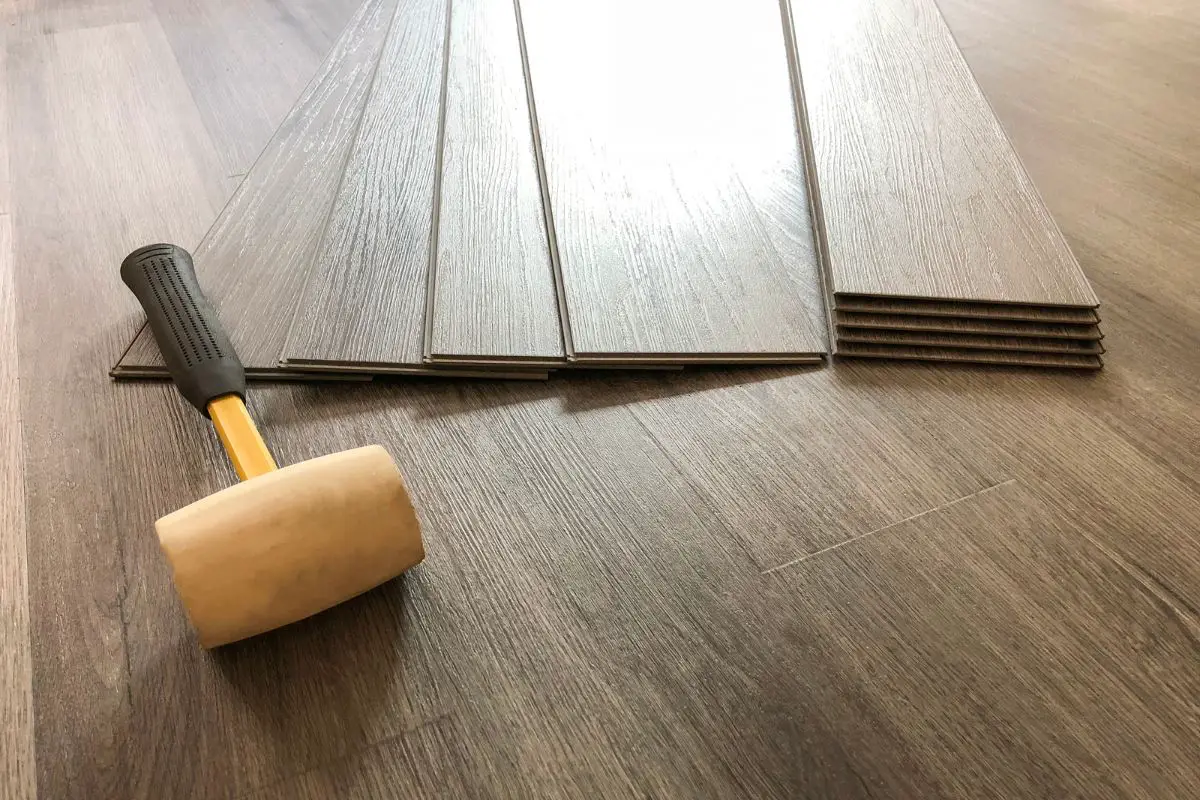Whether you’re looking to upgrade your existing fan or installing a new one, knowing the right size is essential for maximum comfort and efficiency. In this section, we’ll walk you through the process of measuring a ceiling fan and determining its size to ensure the perfect fit for your space.

Before we delve into the details, let’s cover the basics. When it comes to measuring a ceiling fan, understanding the square footage of the room is crucial. It will help you choose the appropriate fan size. We’ll guide you through the steps of measuring the room and calculating the square footage.
Next, we’ll show you how to measure the span or diameter of the fan. Depending on whether the fan has an even or odd blade count, the measurement technique varies slightly. We’ll walk you through both scenarios, so you’ll be equipped with the knowledge to measure any type of ceiling fan.
Once you have the measurements, we’ll provide you with the recommended ceiling fan size based on the square footage of the room. This way, you can be confident that the fan will effectively circulate air and provide the desired level of comfort.
But that’s not all! We’ll also cover additional factors to consider when choosing a ceiling fan, such as the height at which it will hang and the length of the downrod. You’ll learn how these factors can impact the overall functionality and aesthetics of your fan.
Determining Ceiling Fan Height and Downrod Length
When it comes to installing a ceiling fan, determining the correct height and downrod length is essential for optimal performance and aesthetics. In this section, we will guide you through the process of measuring the ceiling height and selecting the appropriate fan height and downrod length.
To begin, measure the height of your ceiling using a tape measure and a step ladder. It is recommended to have a minimum clearance of eight feet from the floor to the blades of the fan. For ceilings lower than eight feet, consider choosing a low-profile ceiling fan that positions the blades closer to the ceiling. This ensures that the fan operates safely and efficiently, without any risk of accidents or discomfort.
On the other hand, if your ceiling height is nine feet or higher, a ceiling fan with a downrod is the recommended option. The downrod helps to lower the fan to an appropriate height, allowing for better air circulation and an enhanced aesthetic appeal. To determine the ideal downrod length, calculate the difference between the ceiling height and the desired hanging height, taking into account the fan’s height. This calculation will provide you with the necessary measurement to achieve the desired visual effect.
Keep in mind that when measuring the downrod length, it is essential to consider any potential obstacles such as cabinets or furniture that could interfere with the fan’s rotation. By taking these factors into account, you can ensure that your ceiling fan is installed at the perfect height for both functionality and style.

Additional Factors to Consider for Choosing a Ceiling Fan
When selecting the perfect ceiling fan for your space, there are several additional factors to take into consideration. These factors will ensure that your ceiling fan not only provides optimal air circulation but also seamlessly integrates with your room’s design and layout. Let’s explore these important factors:
Ceiling Fan Light Kits
If you’re looking to add both functionality and style to your room, consider opting for a ceiling fan with a light kit. These integrated light fixtures offer convenient illumination while saving space and enhancing the overall aesthetics of your ceiling fan. When assessing the height of your ceiling fan, remember to account for the additional height that the light kit will add.
Ceiling Shape
Another important consideration is the shape of your ceiling. If your ceiling has a slope or angle greater than 32 degrees, you may need to utilize an angled ceiling mount adapter to ensure proper installation. This adapter will allow your ceiling fan to be mounted securely, providing optimal performance in rooms with angled ceilings.
Mounting the Fan
Before installing your ceiling fan, it’s essential to ensure that the area of the ceiling where it will be mounted is both structurally sound and appropriate for electrical connections. Confirm that your ceiling can support the weight of the fan and that there is a suitable electrical junction box in place. Taking these precautions will guarantee the safe and efficient operation of your ceiling fan.
Obstacles on the Ceiling
Lastly, consider any potential obstacles on your ceiling that may impede the rotation of the fan blades. Take note of light fixtures, beams, or other objects that could obstruct the airflow or cause damage to the fan. By carefully assessing the ceiling and addressing any obstacles, you can ensure that your ceiling fan operates smoothly and effectively.

Conclusion
Measuring a ceiling fan and choosing the right size is crucial for optimal air circulation and aesthetics in your room. By measuring the square footage of your room and comparing it to the fan’s sweep or diameter, you can determine the appropriate size that will effectively cool your space. Remember, a fan that is too small won’t provide sufficient airflow, while a fan that is too big may overpower the room.
Consider the height of your ceiling as well. Select a fan with the right downrod length to ensure proper clearance and prevent any accidents. A fan that hangs too low can be hazardous and cause injuries. On the other hand, a fan that hangs too high may not effectively circulate the air in the room. Finding the perfect balance is essential for functionality and safety.
In addition to size and height, consider other factors that may affect the installation and performance of your ceiling fan. If you opt for a fan with a light kit, remember to account for the additional height that the light kit will add. Also, take into consideration the shape of your ceiling and any potential obstacles that may impede the rotation of the fan blades. These factors will help you choose the right fan that fits your needs and complements your room’s design.
When it comes to ceiling fans, there’s no one-size-fits-all solution. Every room is unique, and it’s essential to take into account various factors when making your selection. By considering the size, height, and other relevant factors, you can choose the perfect ceiling fan that not only keeps you cool but also enhances the overall ambiance of your space.
FAQ
Q: How do I measure the size of a ceiling fan?
A: To measure the size of a ceiling fan, determine the square footage of the room and choose a fan with the appropriate sweep or diameter. Install a 42-inch sweep fan in rooms up to 144 square feet, a 44-inch sweep fan in rooms from 144 to 225 square feet, and a 52-inch sweep fan in rooms from 225 to 400 square feet.
Q: How do I determine the height at which a ceiling fan should hang?
A: Measure the ceiling height and consider the recommended height of at least eight feet from the floor. For ceilings less than eight feet, choose a low-profile ceiling fan. For ceilings nine feet or more, use a fan with a downrod, and calculate the length of the downrod based on the desired hanging height.
Q: What other factors should I consider when choosing a ceiling fan?
A: Take into account the presence of a light kit and the additional height it will add. Consider the shape of the ceiling and determine if an angled ceiling mount adapter is required for slopes or angles greater than 32 degrees. Ensure that the area of the ceiling where the fan will be mounted is strong enough and has the appropriate electrical junction box. Check for any obstacles on the ceiling that could impede the rotation of the fan blades.
Q: Why is measuring a ceiling fan and choosing the right size important?
A: Measuring a ceiling fan ensures optimal air circulation and aesthetics in a room. By selecting the right size based on the square footage and considering other factors such as height, additional features, and any obstacles, you can choose the perfect ceiling fan to keep your space cool and stylish.
- What Kind of Room Has No Doors or Windows? - December 1, 2023
- What is a Powder Room? - December 1, 2023
- What Is a Kitchenette: Exploring the Features and Benefits of a Compact Kitchen - December 1, 2023










